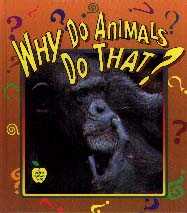|
________________
CM . . . .
Volume V Number 11 . . . . January 29, 1999
excerpt: Opossums and other animals, such as the hognosed snake and pale prominent moth, play dead to avoid being eaten by predators. Most predators will not eat an animal unless they kill it themselves. When a predator threatens an opossum, the opossum falls unconscious. It does not move or make a sound and looks as if it has died.In Why Do Animals Do That? which is targeted for younger students, Kalman answers frequently-asked questions about animal behaviour. Sixteen chapters, each covering one or two pages, deal with a variety of topics such as hibernation, camouflage, mimicking, imprinting and bioluminescence. Brief examples showing each type of behaviour are given. The large-sized text is very simply written and easy for youngsters to read. Colourful headings pose the various questions. Words in boldface type appear in a glossary. A table of contents and a very short index are also included. The book's layout is very attractive. Numerous colour photographs in different sizes are bordered by a thin earth-toned band. Though the photos are not labelled, they match the text and are positioned appropriately. Further, very brief information about the photos can be found at the back of the book. There is also a list of photo credits. The writing team of Kalman and Nickles shows its sense of humour through finishing touches guaranteed to appeal to children. A close-up of a chimpanzee, in a pose reminiscent of Rodin's "The Thinker," appears on the cover. After examining the title and the cover photo, readers will almost be able to hear the chimp going, "Hmmm." Small colourful sketches suited to the topic dance across the page. For example, the section on migration has a flock of geese flying south for the winter; the chapter on malodorous animals shows a field of fragrant wildflowers; a line of ants marches across the page about animals that depend on each other. This attention to detail does not stop there - even the page numbers are printed on tiny cartoon-like chameleons. Though the basic concept of this question-and-answer type animal book is certainly not new, the book succeeds because of its attractive layout. Beginning readers of non-fiction will find it to their liking. Recommended. Gail Hamilton is the teacher-librarian at Bird's Hill School, East St. Paul, Manitoba.
To comment on this title or this review, send mail to cm@umanitoba.ca.
Copyright © the Manitoba Library Association.
Reproduction for personal use is permitted only if this copyright notice
is maintained. Any other reproduction is prohibited without
permission.
Published by
TABLE OF CONTENTS FOR THIS ISSUE - JANUARY 29, 1999.
AUTHORS |
TITLES |
MEDIA REVIEWS |
PROFILES |
BACK ISSUES |
SEARCH |
CMARCHIVE |
HOME
|

